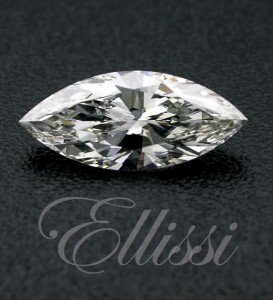The Marquise Diamond is possibly one of the least utilised cuts in engagement rings of all the standard top ten cuts available. The reason for this is mostly due to its elongated shape and pointed ends. This gives the marquise diamond quite difficult proportions when it comes to user friendly ring designs.

The Marquise diamond does have some advantages though, in particular its weight distribution. A marquise diamond has a relatively shallow depth when compared to some of the other cut types. This gives quite a bit of additional length in the diamond. This additional length means the engagement ring will have a great size advantage.
Having a Marquise cut diamond ring design is quite a unique choice for an engagement ring. It is one diamond type that you can rely upon to give a very individual design concept. This is especially the case when you get the best advice and have a ring custom made by Ellissi.
The cost of Marquise diamonds can be very attractive especially when compared to the most costly cut shape which is the round brilliant cut. Very large sizes in marquise diamonds are are in short supply. They can command premium prices if you want a diamond that is above 2.00 ct.
The Marquise Diamond design.
Setting this type of diamond shape usually requires the pointed ends to be protected in some way by the setting. There are a few reasons why this is necessary. Probably the most important of these, is that the pointed ends are quite thin and sharp. Protecting them will prevent them from becoming accidentally damaged. Protecting the ends also eliminate the risk of scratching people too.
The marquise cut diamond shares some attributes with other diamonds like the Oval Diamond and also the Pear cut diamond. Typical of these diamonds is an effect that is referred to as the “Bow Tie”. This is basically the result of a difference in proportion along the length of the diamond.
The depth and the cut angles of the diamond change from the shallow outer ends to the central main body of the diamond. This gives rise to a differing look in the way the facets in these areas refract light. The result is that the facets in the centre refract light in such a way as to resemble a “bow tie”. The bow tie appearance is across the centre of the diamond when the diamond in the upright position (points north, south).

